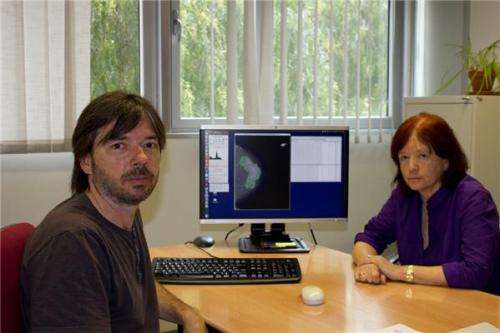New software aids breast cancer risk assessment

Researchers of the Universitat Politècnica de València, in collaboration with the Instituto de Salud Carlos III and the Foundation for the Health and Biomedical Research of the Comunitat Valenciana, have developed DMScan, new software to aid breast cancer risk assessment. From the images obtained in mammograms, the software objectively quantifies breast density, a value directly related to the risk of this pathology.
"The breast is basically composed of adipose tissue and fibroglandular tissue; the density is the proportion of the latter to the breast size. Our software quantifies this value, distinguishing dense tissue from fat tissue. It offers a continuous and much more objective measurement than the doctors give today, based on a visual inspection. This is therefore a new aid to breast cancer diagnosis," says Rafael Llobet, researcher at the Computer Technology Institute (ITI, in Spanish) of the Universitat Politècnica de València.
The software can work in automatic and assisted mode. In the latter, the user can adjust different parameters associated to the density calculation. "So far, the assisted read-out, done by an expert radiologist, provides better-quality information, but the availability of an automatic read-out is of great interest in an initial assessment of density when processing a large number of mammogram," states Rafael Llobet.
Shape recognition, learning and computer vision
DMScan incorporates shape recognition, automatic learning and computer vision techniques. It also includes a statistical model created from a database of 650 mammograms, which allows it to classify new tests. "We use these images in order to train the system, as reference standards, so when a new mammogram is introduced into the system it can compare it to that corpus and classify it," explains Rafael Llobet.
Research
Besides its medical application, DMScan is interesting for research purposes and for studies related to breast density from a large number of images. "For example, if breast density could be related to a certain genotype", adds Rafael Llobet.
About breast cancer
According to the study of the researchers from the UPV, FISABIO and ISCIII, "women with denser breasts have more breast cancer risk. However, it must be taken into account that breast density decreases with age and with the body mass index, two factors also related to the probability of having breast cancer and that have been taken into account in this work".
Breast cancer is the malignant tumour with the highest incidence in women from around the world, with more than 1,6 million new cases diagnosed every year. In Spain, there are more than 25.000 new diagnoses every year. Despite the high survival rate from this tumour, it still causes more than 6.000 deaths every year among Spanish women.
More information: Llobet, R., Pollán, M. Antón, J., Miranda-García, J., Casals, M., Martínez, I., Ruiz-Perales, F., Pérez-Gómez, B., Salas-Trejo, D., Pérez-Cortés, J.-C. "Semi-automated and fully automated mammographic density measurement and breast cancer risk prediction." Computer Methods and Programs in Biomedicine. DOI: 10.1016/j.cmpb.2014.01.021
















